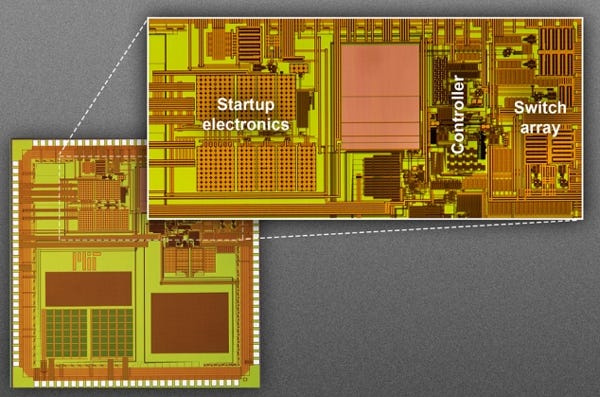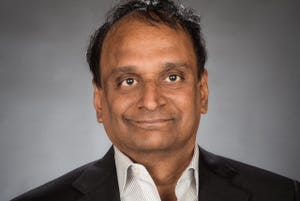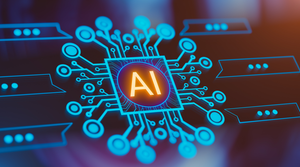July 2, 2015
Researchers unveil a new ultra-low power circuit that can harvest more than 80% of the energy it takes in. They say it is nearly twice as efficient as any existing sensor technologies.
Kristopher Sturgis
|
The MIT researchers' prototype for the chip measures just 3 mm by 3 mm. Magnified detail shows the chip's main control circuitry, which measures just 2.2 mm by 1.1 mm. (Image courtesy of MIT) |
MIT researchers recently unveiled a new power converter chip that can harvest more than 80% of the energy it absorbs, despite its extremely low levels of power consumption as a tiny solar cell.
The chip, unveiled at the Symposia on VLSI Technology and Circuits last month, was specifically designed to achieve such efficiency standards, while simultaneously performing additional responsibilities.
The new sensor has proven to be almost twice as efficient as any existing ultra-low power converter that uses similar technology, as even the best predecessors were only able to harvest 40% or 50% of the energy they absorbed, according to an MIT news release.
While most of these predecessors used solar cells to either charge a battery, or directly power a device itself, this new chip can do both. Dina Reda El-Damak, a graduate student in electrical engineering and computer science at MIT and first author on the paper describing the work, spoke about its unique qualities as a power source and how it can operate efficiently with limited resources.
"The unique thing about it is that it can operate very efficiently with very limited input power," El-Damak said. "Our ultra-low power circuit can interface with a solar cell and provide a regulated output voltage supply to power ultra-low power sensors, as well as charge a battery with any excess power that is not required by the load. It can use the battery to power the device directly when power is not available from the input."
These new sensors could be the next step forward toward the realization of the "Internet of Things"--the concept that all of the devices around us, from manufacturing equipment and vehicles to household appliances, could all communicate and report information through a network of servers, all in an effort to streamline maintenance and the coordination of tasks. Achieving such a network of fluid operations and communication will require efficient, reliable power sources that can run for months at a time, if not power themselves individually.
"If these devices can be powered using the energy free in our surroundings--such as solar, thermal, or vibration--then the device can run for months or even years without the need for changing a battery," Damak says. "This could have a big impact on applications such as implantables and infrastructure monitoring where it is highly inconvenient to replace the battery."
Damak went on to say that their work is particularly unique because they were able to reduce the amount of power required by the chip without compromising the tasks performed. This was achieved by enabling the chip to operate in an asynchronous fashion--which means it only clocks the circuits on demand, and shuts down when all the power transfers are done.
As for the future of the chip, Damak and her group hope to continue to enhance the chip in an effort to maximize both efficiency and its ability to perform tasks. They even hope to expand its ability to harvest energy from additional sources which could increase its efficiency beyond current thresholds.
"The ultra-low power techniques demonstrated by this chip can have a positive impact on various other energy harvesting sources," Damak said. "We'd like to expand these ideas to cover other sources, and we hope in a year or two, the technology will be deployed on the market."
Refresh your medical device industry knowledge at MEDevice San Diego, September 1-2, 2015. |
Kristopher Sturgis is a contributor to Qmed and MPMN.
Like what you're reading? Subscribe to our daily e-newsletter.
About the Author(s)
You May Also Like



.png?width=300&auto=webp&quality=80&disable=upscale)